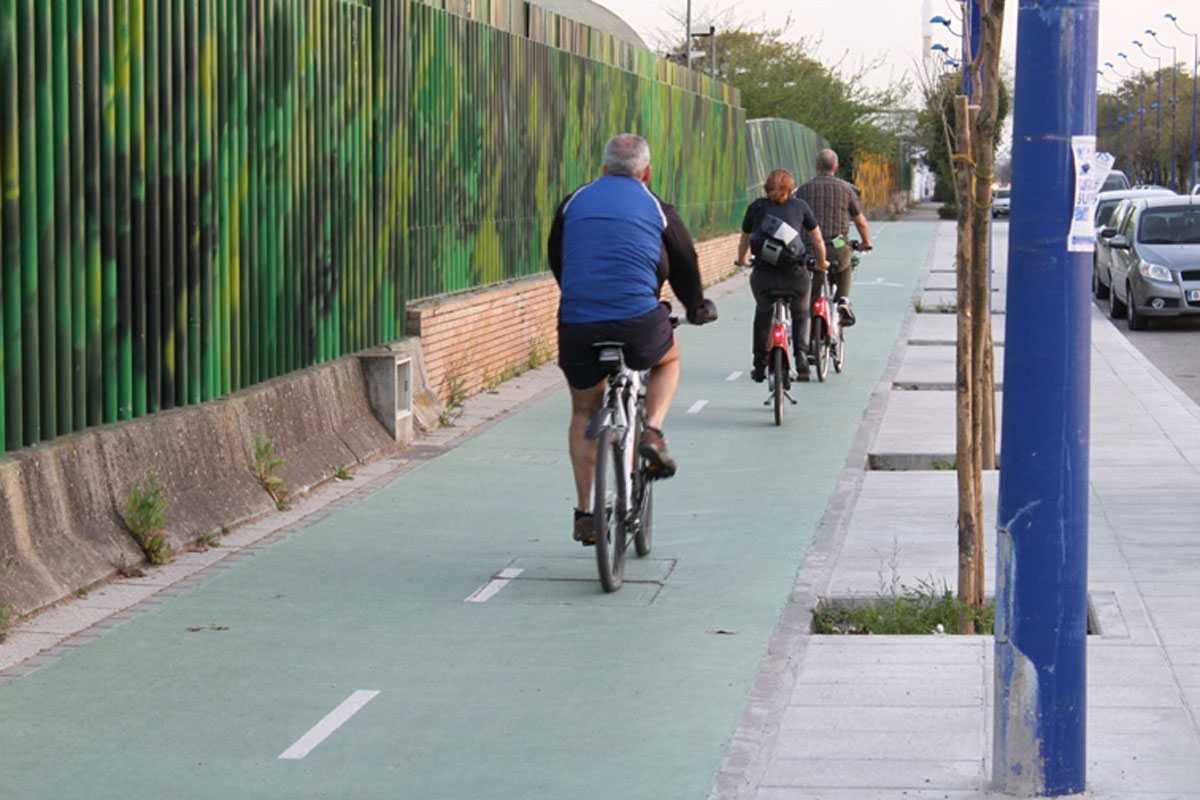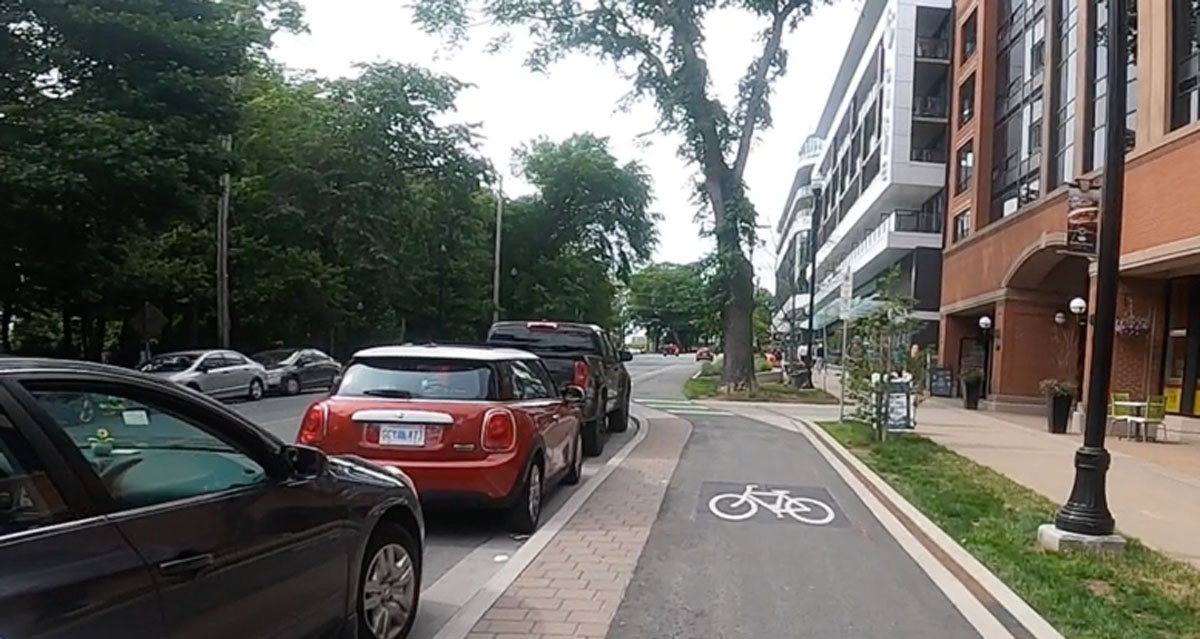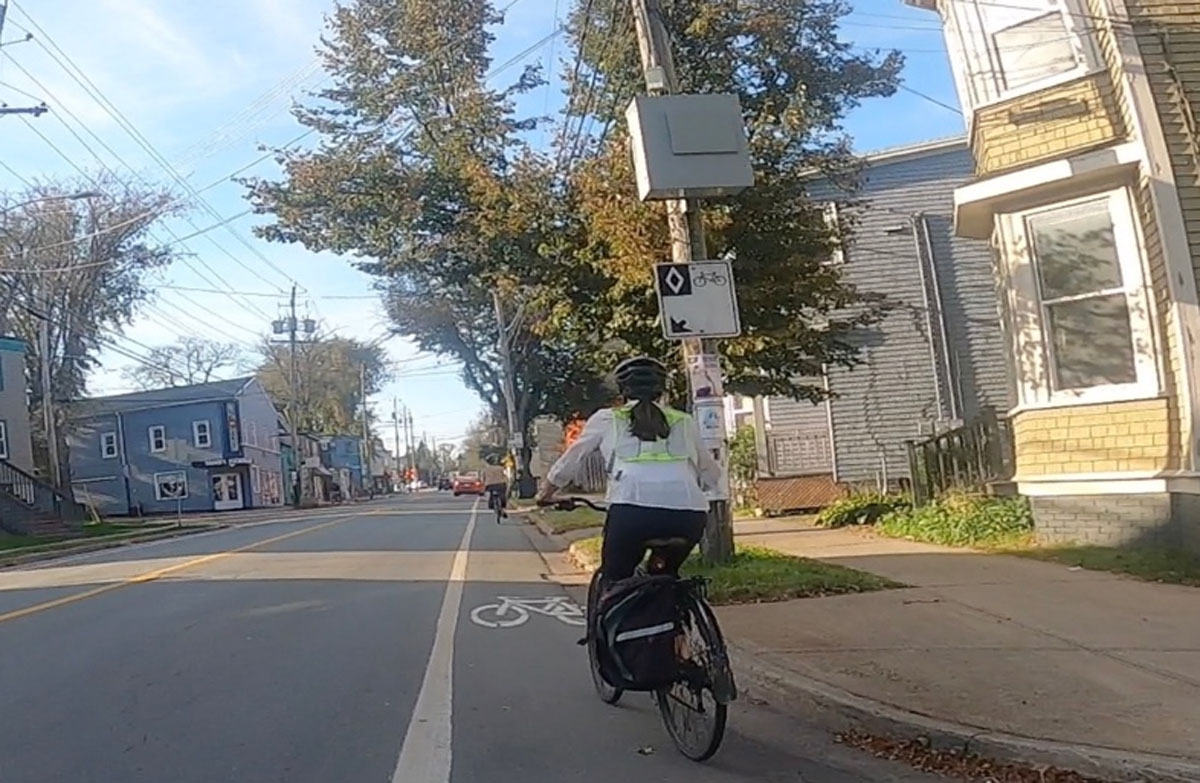Introduction
The latest report from the UN Intergovernmental Panel on Climate Change urges local governments to implement an active transportation infrastructure to reduce greenhouse gas emissions (IPCC, 2023). Cycling is one of the most sustainable modes of urban transport, and it promotes health through physical activity (Liu, Siddiq and Zhang, 2022; European Cycling Federation, 2016). Research shows that building a complete, minimum grid of cycling infrastructure is an essential step to achieving a large-scale shift from driving to cycling, especially when the network is designed for people of all ages and abilities (Szell et al., 2022). Some cities have achieved this milestone faster than others. In Halifax, Canada, a connected minimum grid that has long been promised is behind schedule (as of 2023), while in Seville, Spain, such a grid was implemented in under two years. In this article, we identify three lessons that cities in a similar situation to Halifax can learn from Seville to build a cycling infrastructure quickly and efficiently without compromising safety.
Halifax is a hilly midsize port city with a population of 440,000 (Government of Canada, 2022). Traditionally, it is the ancestral land of the Mi’kmaq peoples, and it was named “Kjipuktuk”, meaning “Great Harbour”. The need for a safe bicycle network has long been a priority in Halifax. In 1999, a coalition of research and academic groups published a bikeway strategy that identified that Halifax lagged behind other cities nationally and internationally in providing safe cycling routes (Bikeways Research Team, 1999). In 2014, the Halifax Regional Municipality (HRM) adopted a municipal bike plan called “Making Connections”, which set a target to create a connected grid in the regional center by 2019 (Halifax Regional Municipality, 2014). In 2017, the plan was folded into the region’s new Integrated Mobility Plan (IMP), whose goal was to “deliver a Regional Centre all ages and abilities bicycle network by 2022” (Halifax Regional Municipality, 2017). Therefore, the adoption of the IMP pushed back the completion date for the connected grid by an additional three years.
HRM’s Council declared a climate emergency in January 2019, further creating a sense of urgency to complete the cycling infrastructure (Zurawski, 2019). Although largely symbolic, the declaration undertakes to “[incorporate] into the Municipality’s climate targets and actions the need to achieve net zero carbon emissions before 2050 and net negative carbon emissions in the second half of the century” (Zurawski, 2019). This emphasizes the importance of planning documents like the IMP to guide actions towards more sustainable forms of travel, such as walking and cycling. Halifax’s mayor announced an additional 14km of protected bike lanes in 2019 to be built using $25m CDN of funding across three levels of government (Laroche, 2019). The mayor asked city staff to accelerate the plan for the new bike lanes from ten years to three, stating, “come hell or high water, this city will be a cycling city” (Laroche, 2019).
By the end of 2022, less than half of the promised network had been completed, leaving Halifax far from the goal of becoming a city with high rates of cycling (Bauman, 2022). Fewer than 1% of residents bike to work across the whole municipality (which encompasses urban, suburban and rural communities) (Government of Canada, 2022). This low rate is in contrast to the fact that 50% of survey respondents from Halifax who had not cycled in the last year declared they would consider biking more if the cycling infrastructure was improved (Cities, Health & Active Transportation Research Lab, 2022).
In contrast, Seville, swiftly implemented a bike network. Seville is the fourth largest city in Spain, with a population of 685,000. In 2003, Seville committed to building 80km of segregated bike lanes to create a minimum grid of continuous, uninterrupted lanes that would connect most major neighbourhoods of the city (Calvo and Marqués, 2020). As in Halifax, most of the bike lanes replaced street parking. Seville’s then Mayor, Alfredo Sánchez Monteseirín, was concerned that the network could spark a backlash from drivers, so he prioritized building the grid within a single election cycle to attract a large number of cyclists quickly (Marqués et al., 2015). Heavy bicycle traffic would help justify the lost parking, while also creating a constituency of users who would defend the bike lanes against their opponents (Walker, 2015). The Mayor was successful in this goal (Marqués et al., 2015). Seville’s success offers three lessons for Halifax and other cities attempting to implement a minimum grid: 1) invest and mobilize sufficient funds to build a complete network quickly; 2) Create dedicated institutions to implement the network; and 3) use best practice designs from the start. In this tale of two cities, we describe these three lessons from which others can learn.
Lesson 1: Invest and mobilize sufficient funds
Seville chose to treat bicycle network construction as a major project, worthy of significant upfront capital expenditure, and similar to what cities are often willing to spend on bridges or subways (Andersen, 2018). This allowed the city to finish the minimum grid in less than two years, between 2006 and 2007. As hoped, it had a major impact: the number of cycling trips rose by 452% in just three years (Calvo and Marqués, 2020). This success helped to create political momentum for the project, and the city now boasts over 160 km of bike lanes (Marqués et al., 2015).
Although investment for Halifax’s bicycle network was committed in 2019 and municipal support seemed to be high (Laroche, 2019), Halifax’s cycling network remains behind schedule, with further delays and cost overruns for important upcoming segments of the network (Bauman, 2022). What caused the delay in implementation? The ability to mobilize existing funding appears to be lacking within the bureaucratic processes of City Hall, which can be illustrated through the Peninsula South Complete Streets bike lane planning process (Halifax Regional Municipality, n.d.). This is a crucial east-west protected bike lane to link the biggest universities and the hospitals to the existing north-south routes in the downtown. The city held the initial public consultation in October 2019, with a second consultation three years later in August 2022. Before construction can begin, a final report needs to be submitted for council approval, and only then will the preliminary and detailed design be determined (Halifax Regional Municipality, n.d.).
The slow pace suggests Halifax did not allocate sufficient staff resources to finish the project on a timely schedule, which has put the project at political risk despite the availability of funding. It is also possible that the lack of resources is due to larger structural issues of sustainability plaguing North American cities–and Halifax specifically (Stickland, 2023; Stickland, 2022a). It is common for bicycle lane opponents to draw attention to the low numbers of people who currently use the city’s existing disconnected bike lanes (Butler, 2019) but the same argument could also be made for rural roads. Moving slowly to build a minimum grid is not a financially sound strategy if it politically jeopardizes the project. If opposition halts construction before a complete grid is achieved, or leads to lanes being removed, it means the funds spent on the partial grid will have achieved minimal societal value.
Lesson 2: Create dedicated institutions to implement the network
Lesson 1 illustrates that financial investment, while necessary, is not sufficient if there is no mechanism to overcome institutional bottlenecks. To ensure success, Seville created institutional structures that allowed it to implement its bicycle network quickly. The city’s leadership established a new municipal body within the Planning Department called the Oficina de la Bicicleta, dedicated to implementing bike lanes (Marqués et al., 2015). Critically, the department was given independent authority over street design, separate from that of the transportation department (Marqués et al., 2015). There is a tendency for today’s transportation departments to prioritize vehicular traffic flow over more active modes of transportation, partly because the transportation engineering profession has focused on car-oriented design for most of its history (Hebbert, 2005; Cleveland, 2023). Institutional path dependence therefore favours car-oriented design in these departments (Urry, 2008; Driscoll, 2014). Of note, in 2005, Seville’s transportation department attempted to halt the construction of bike lanes, because they would not have given approval for such a wholesale removal of on-street parking (Walker, 2015). However, the attempt was unsuccessful because the Department had no authority over the Oficina de la Bicicleta, and the Oficina had the backing of the Mayor (Walker, 2015).
HRM has a dedicated Active Transportation team, but it does not have such independent authority over street design, nor a uniform street design standard; instead, it only adheres to “minimum standards” as laid out in the municipal Red Book (Halifax Regional Municipality, 2021; Cleveland, 2023). The team is located within the Transportation and Public Works Department, which is comprised primarily of transportation engineers and has traditionally prioritised motorised traffic flow.
In Seville, the city’s public servants were tasked with designing, building, and adapting the bike network to the needs of the people in the city. Although Halifax’s public servants have the same ultimate task, Halifax’s reliance on Public Private Partnerships to build bicycle infrastructure adds cost and time to municipal projects while also providing less adaptability. In short, in a city where even a “tactical” bike infrastructure requires multiple administrative processes and tenders, the result is a confusing mix of different types of bicycle infrastructure and an over-reliance on ineffective options like signs (Stickland, 2022b) and enforcement (Stickland, 2022c) on a grid that does not bring cyclists to important destinations or allow them to travel on main commercial streets. This leads us to lesson 3.
Lesson 3: Use best practice designs from the start
Seville focused on implementing best-practice bike lane designs from the first phase of the project. The Oficina de la Bicicleta designed the bicycle network for visibility, connectivity, and consistency. They used green paint throughout the network so that cyclists can easily follow it and drivers and pedestrians can easily see it and avoid it, as shown in Figure 1 (Marqués et al., 2015). They used bollards to separate bike lanes from traffic. Later, they designed bike lanes to be flush with sidewalks so that the curb provided protection for the bike lane from traffic. In many places, the city has positioned bike lanes between on-street parking and sidewalks, so that parked cars provide extra protection for cyclists from traffic (Marqués et al., 2015).
Halifax has only recently begun to implement these best practice designs. Its South Park bike lane, completed in 2019 is shown in Figure 2. This short stretch of bike lane is flush with the sidewalk, separated from traffic with parking, and is marked with green paint at intersections (Halifax Regional Municipality, n.d.). However, the city’s first bike lanes consisted only of painted lines (Figure 3), a design that has been shown to have relatively little impact on cyclist comfort or safety (Ferenchak and Marshall, 2016). Some of the city’s bike lanes encourage people to ride in the “door zone” alongside parked cars, where there is a greater risk that someone opening a door will strike a cyclist (Teschke et al., 2012).
The Halifax South Park Street bike lane includes a short, raised section with curb protection, like those found in Seville. The design still puts cyclists in danger through proximity with the door zone and risk of obstruction from people exiting from parked cars (image credit: the authors).
One reason Halifax did not use separated bike lanes in the first phases of construction was that the city needed to update its street design standards and maintenance equipment to enable the new designs (Halifax Regional Municipality, 2021). However, the city also treated the best-practice designs as new and experimental, whereas painted bike lanes better resembled the city’s existing street designs. While it may seem intuitive to treat new designs as riskier, this perspective inverts the established understanding of the level of risk associated with each type of design concerning health and safety. Evidence clearly shows that protected and separated bike infrastructures are safer for all road users (Marshall and Ferenchak, 2019).
Conclusion
With unanimous council approval of the Integrated Mobility Plan and funding to complete the work, Halifax was poised for a rapid acceleration in its cycling infrastructure in 2019–but that opportunity was squandered (Bauman, 2023). The example provided by Seville demonstrates that bicycle infrastructures capable of creating dramatic shifts in transportation modality choices can and should be introduced quickly (Calvo and Marqués, 2020).
Contrasting the processes of these two cities helps to illustrate some of the institutional and bureaucratic barriers that are experienced by cities around the world (Weir, 2019). Whereas Seville was bold and fast in laying out the full network to bring about a rapid shift, Halifax has broken the overall project into small segments involving a laborious and time-consuming process of design and public engagement. Halifax, like Seville, has a dedicated team responsible for active transportation, but the substantial delays indicate that the city does not have the institutional flexibility to adapt to the changing needs of a climate-threatened world, as of the writing of this article. These delays also suggest that Halifax invested insufficiently in human resources, streamlined processes, and upfront funding to expedite a complete network. This lack of prioritisation is a missed opportunity for bold action from which other cities can learn to accelerate cycling rates more effectively. If Halifax’s inadequate bike lanes spark a political backlash, there is a risk that the city will never become the “cycling city” it aspires to be.
Competing Interests
The authors have no competing interests to declare.
References
1 Andersen, M. (2018). Six secrets from the man who Planned Sevilla’s Lightning Bike Network. People For Bikes. Available from https://www.peopleforbikes.org/news/six-secrets-man-planned-sevillas-lightning-bike-network [Accessed 2 April 2023].
2 Bauman, M. (2022). Macdonald Bridge bike flyover delayed to 2024. The Coast. Available from https://www.thecoast.ca/news-opinion/macdonald-bridge-bike-flyover-delayed-to-2024-29775207 [Accessed 5 May 2023].
3 Bauman, M. (2023). Halifax planned to become “a cycling city” in 2022. How’s that coming? The Coast. Available from https://www.thecoast.ca/halifax/halifax-cycling-network-lags-behind-region-promises/Content?oid=29704322 [Accessed 9 February 2023].
4 Bikeways Research Team. (1999). Active transportation 2000: A bikeway strategy for the Halifax Regional Municipality. Halifax, Canada: Dalhousie University.
5 Butler, E. (2019). Who are we building bike lanes for, anyway? Halifax Examiner. Available from https://www.halifaxexaminer.ca/government/city-hall/who-are-we-building-bike-lanes-for-anyway/ [Accessed 7 July 2023].
6 Calvo, M., and Marqués R. (2020). How Seville became a city of cyclists. C40 Knowledge. Available from https://www.c40knowledgehub.org/s/article/How-Seville-Became-a-City-of-Cyclists?language=en_US [Accessed 18 February 2023].
7 Cities, Health & Active Transportation Research (CHATR) Lab. (2022). Impacts of bicycle infrastructure in mid-sized cities study (IBIMS). Vancouver: Simon Fraser University. Available from www.sfu.ca/ibims [Accessed 2 April 2023].
8 Cleveland, T. (2023). Urban intercurrence: The struggle to build walkable downtowns in car-dependent suburbia (dissertation). Available from https://dalspace.library.dal.ca/handle/10222/82562 [Accessed 7 July 2023].
9 Driscoll, P. A. (2014). Breaking carbon lock-in: path dependencies in large-scale transportation infrastructure projects. Planning Practice & Research, 29(3), 317–330. DOI: http://doi.org/10.1080/02697459.2014.929847
10 European Cycling Federation. (2016). Cycle more often 2 cool down the planet – Quantifying CO2 savings of cycling. Available from https://ecf.com/groups/cycle-more-often-2-cool-down-planet-quantifying-co2-savings-cycling [Accessed 25 May 2023].
11 Ferenchak, N. N., and Marshall, W. (2016). The relative (in)effectiveness of bicycle sharrows on ridership and safety outcomes. Available from https://trid.trb.org/view/1393928 [Accessed 7 July 2023].
12 Government of Canada. (2022). Profile table, census profile, 2021 census of population – Halifax, Regional Municipality (RGM) [Census subdivision], Nova Scotia. Available from https://www12.statcan.gc.ca/census-recensement/2021/dp-pd/prof/index.cfm?Lang=E [Accessed 15 November 2022].
13 Halifax Regional Municipality. (2014). 2014–2019 Halifax Active Transportation Priorities Plan. Halifax: Halifax Regional Municipality. Available from https://legacycontent.halifax.ca/council/agendasc/documents/140909ca1141.pdf.
14 Halifax Regional Municipality. (2017). Integrated Mobility Plan. Halifax. Available from https://cdn.halifax.ca/sites/default/files/documents/about-the-city/regional-community-planning/IMP_report_171220-WEB.pdf.
15 Halifax Regional Municipality. (2021). Municipal design guidelines. Available from https://www.halifax.ca/transportation/streets-sidewalks/municipal-design-guidelines-red-book [Accessed 7 July 2023].
16 Halifax Regional Municipality. (n.d). Cycling: South Park Street. Available from https://www.halifax.ca/transportation/cycling-walking/expanding-network/south-park-protected-bicycle-lanes [Accessed 7 July 2023].
17 Halifax Regional Municipality. (n.d). Peninsula South complete streets: Shape your city Halifax. Available from https://www.shapeyourcityhalifax.ca/peninsula-south-complete-streets [Accessed 7 July 2023].
18 Hebbert, M. (2005). Engineering, urbanism and the struggle for street design. Journal of Urban Design, 10(1), 39–59. DOI: http://doi.org/10.1080/13574800500062361
19 Intergovernmental Panel on Climate Change. (2023). AR6 synthesis report. Climate Change 2023. Available from https://www.ipcc.ch/report/ar6/syr/.
20 Laroche, J. (2019). $25M allows Halifax to shift bike lane project into high gear CBC News. Available from https://www.cbc.ca/news/canada/nova-scotia/bike-lanes-active-transportation-federal-nova-scotia-halifax-1.5228834 [Accessed 10 May 2022].
21 Liu, S., Siddiq, A., and Zhang, J. (2022). Planning bike lanes with data: Ridership, congestion, and path selection. SSRN Electronic Journal. [Accessed 2 April 2023]. DOI: http://doi.org/10.2139/ssrn.4055703
22 Marqués, R., et al. (2015). How infrastructure can promote cycling in cities: Lessons from Seville. Research in Transportation Economics, 53, 31–44. DOI: http://doi.org/10.1016/j.retrec.2015.10.017
23 Marshall, W. E., and Ferenchak, N. N. (2019). Why cities with high bicycling rates are safer for all road users. Journal of Transport & Health, 13, 100539. DOI: http://doi.org/10.1016/j.jth.2019.03.004
24 Stickland, M. (2022a). The suburbs are a Ponzi scheme. The Coast. Available from https://www.thecoast.ca/news-opinion/the-suburbs-are-a-ponzi-scheme-29827137 [Accessed 7 July 2023].
25 Stickland, M. (2022b). Car-free Spring Garden Road failure exposes flaws in HRM thinking. The Coast. Available from https://www.thecoast.ca/news-opinion/car-free-spring-garden-road-failure-exposes-flaws-in-hrm-thinking-29359409#google_vignette [Accessed 7 July 2023].
26 Stickland, M. (2022c). What is the point of the police? The Coast. Available from https://www.thecoast.ca/news-opinion/what-is-the-point-of-the-police-29950417 [Accessed 7 July 2023].
27 Stickland, M. (2023). Explaining the wildcards at play in the Tantallon wildfire. Available from https://www.thecoast.ca/news-opinion/explaining-the-wildcards-at-play-in-the-tantallon-wildfire-30902221 [Accessed 7 July 2023].
28 Szell, M., et al. (2022). Growing urban bicycle networks. Scientific Reports, 12(1), 6765. DOI: http://doi.org/10.1038/s41598-022-10783-y
29 Teschke, K., et al. (2012). Route infrastructure and the risk of injuries to bicyclists: A case-crossover study. American Journal of Public Health, 102(12), 2336–2343. DOI: http://doi.org/10.2105/AJPH.2012.300762
30 Urry, J. (2008). Governance, flows, and the end of the car system? Global Environmental Change, 18(3), 343–349. DOI: http://doi.org/10.1016/j.gloenvcha.2008.04.007
31 Walker, P. (2025). How Seville transformed itself into the cycling capital of southern Europe. The Guardian. Available from https://www.theguardian.com/cities/2015/jan/28/seville-cycling-capital-southern-europe-bike-lanes [Accessed 2 April 2023].
32 Weir, D. (2019). Unlocking the potential of tactical urbanism for active transport promotion in Auckland (dissertation). Available from https://www.herengaanuku.govt.nz/assets/DWeir-WAC-Dissertation.pdf [Accessed 7 July 2023].
33 Zurawski, R. (2019). Climate Emergency. Available from https://cuspnetwork.ca/documents/members/halifax/ced/190129rc1471.pdf [Accessed 8 October 2022].



